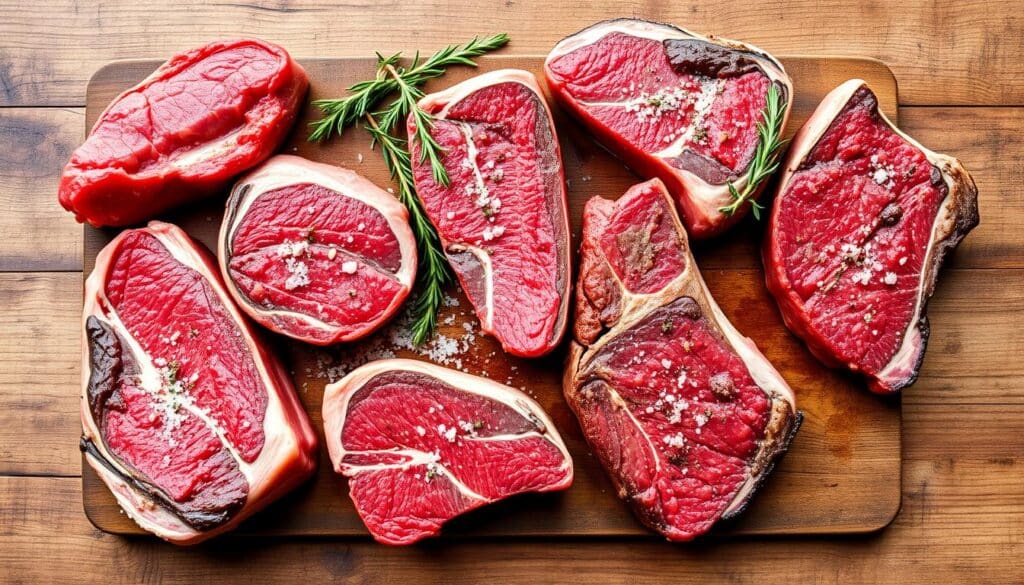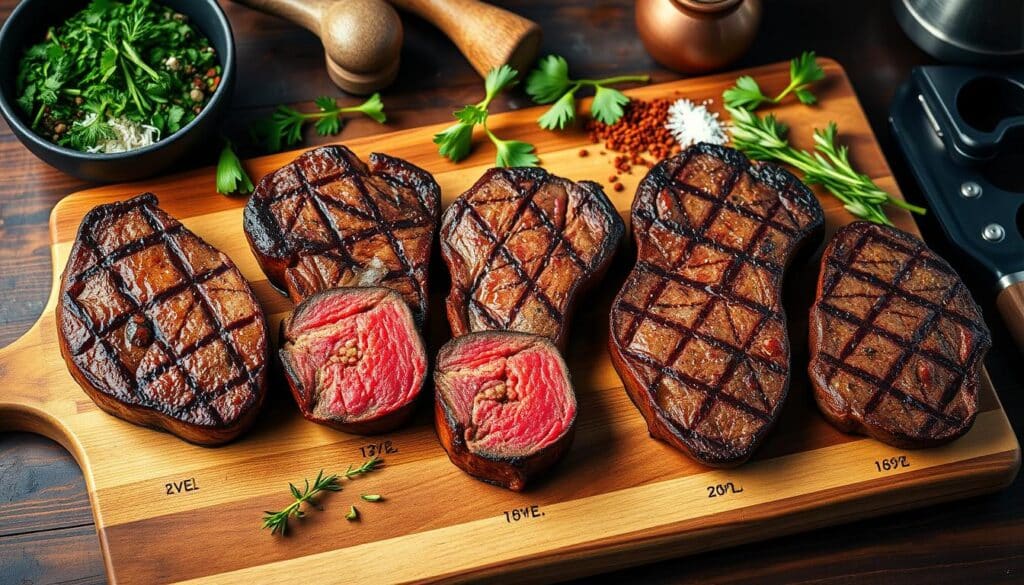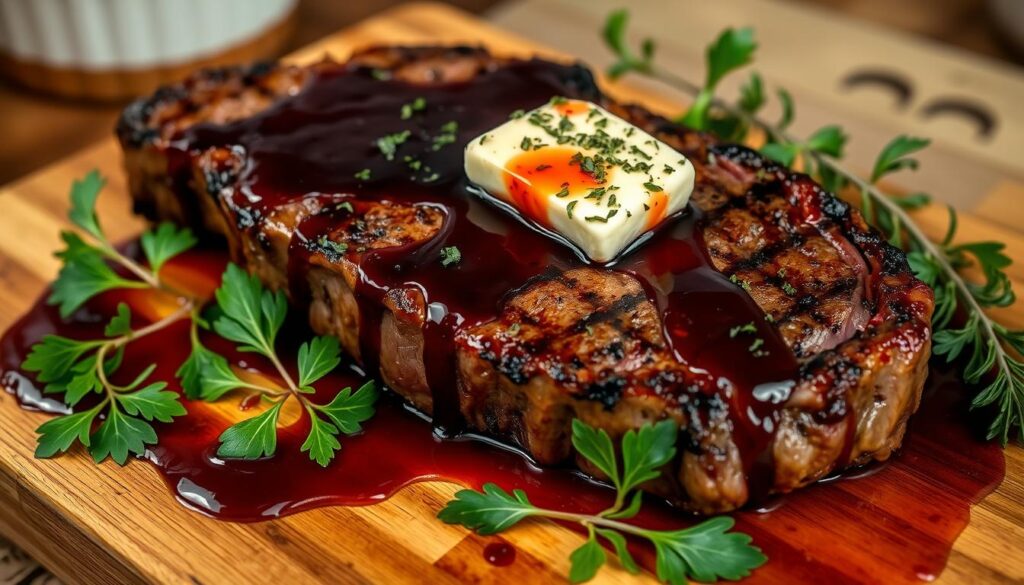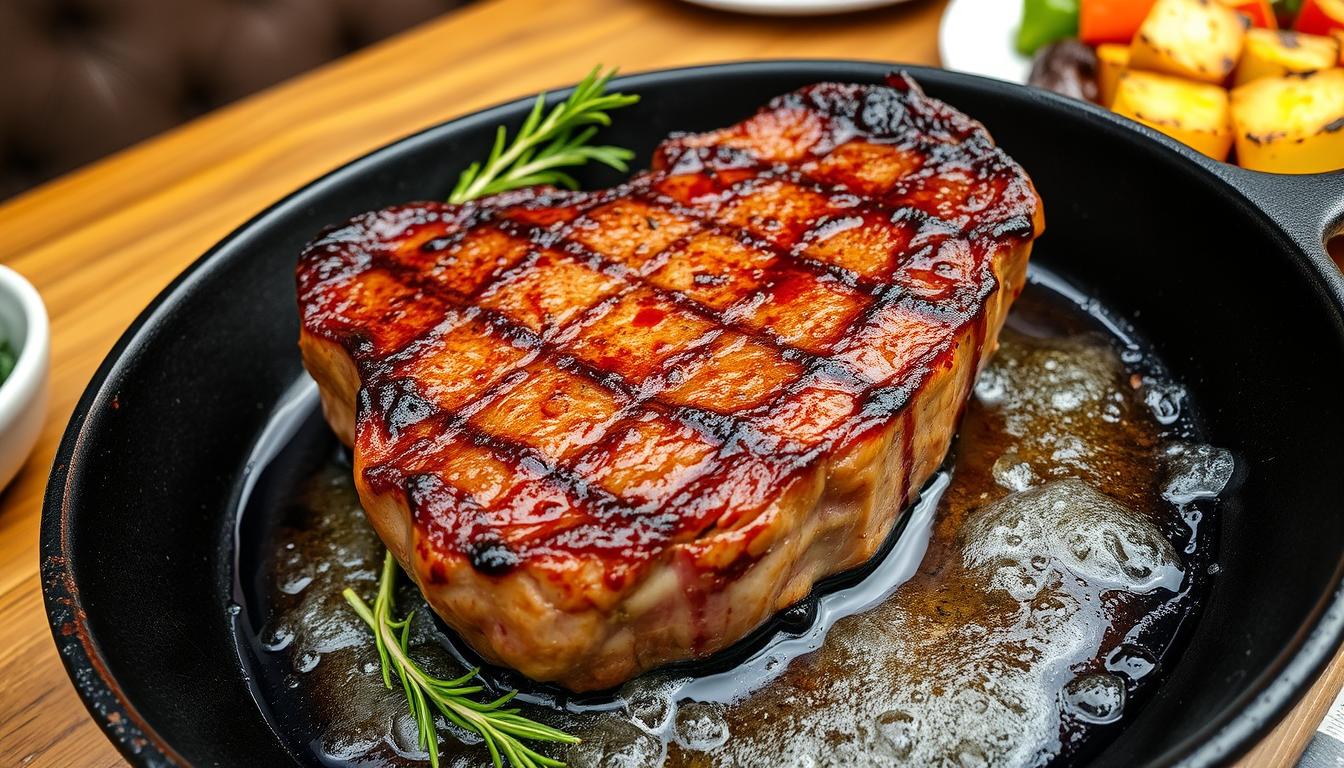Want a juicy steak but don’t want to spend a lot at a fancy restaurant? We’ve got you covered. Cooking the perfect steak at home is an art. We’re here to help you master it. For a flavorful twist, check out our Steak Fra Diavolo Recipe, combining tender steak with a spicy tomato sauce. View Recipe.
Whether you love barbecue or are new to steak, our tips will make you better. We’ll cover everything from picking the right cut to mastering temperature control. Get ready to impress your family and friends with steak that’s as good as a restaurant’s, all from your kitchen!
Essential Equipment for Perfect Steak Preparation
Cooking a delicious steak starts with the right tools. We’ve made a guide to help you get your kitchen ready for steak success.
Cast Iron Skillet vs. Grill Pan
For indoor steak cooking, two top choices are the cast iron skillet and the grill pan. Cast iron skillets keep heat well, giving a great sear. Grill pans have ridges for barbecue-like marks. Your choice depends on your cooking style and what you want.For an outdoor option, explore our Cowboy Steak Grilling Guide, perfect for mastering bold barbecue flavors. View Recipe.
Digital Meat Thermometer Guide
A digital meat thermometer is key for perfect steak doneness. It removes the guesswork, ensuring your steak is just right. Choose models that read fast and have clear displays.
Tongs and Other Essential Tools
Tongs are key for handling steaks while cooking. They let you flip steaks carefully without breaking them. You’ll also need a strong spatula, a sharp knife, and a cutting board. Grilling fans should have a wire brush for grates.
Having these tools in your kitchen will help you grill steaks like a pro. Whether you’re pan-searing or grilling, the right gear makes a big difference. You’ll be able to make steaks as good as those in restaurants at home.
Choosing the Right Cut of Beef
Choosing the right cut of beef is key for a great steak dinner. We’ll help you pick the perfect steak.
Understanding Prime vs. Choice Grades
Beef grades show the meat’s quality and tenderness. Prime has lots of marbling for better flavor. Choice is less expensive but very tasty. Think about your budget and taste preferences.
| Grade | Marbling | Tenderness | Price |
|---|---|---|---|
| Prime | Abundant | Very High | Premium |
| Choice | Moderate | High | Moderate |
Popular Steak Cuts Explained
Each steak cut has its own taste and feel. Here are some favorites:
- Ribeye: Rich flavor and tender
- Tenderloin: The tenderest, also called filet mignon
- New York Strip: Lean with a strong beef taste
- Sirloin: Versatile and lean, with great flavor

Marbling and Its Importance
Marbling is the white fat in the meat. It melts when cooked, adding flavor and juiciness. Skirt steak is tasty and has good marbling, great for fajitas or grilling. More marbling means richer taste and tender meat.
“The secret to a great steak lies in its marbling. It’s nature’s flavor enhancer.”
The Science Behind Perfect Steak
Cooking the perfect steak is more than just skill. It’s a science. We’ll look at how raw beef turns into a delicious dish.
The Maillard reaction is key to steak’s flavor. It happens when proteins and sugars meet high heat. This creates hundreds of flavors that make steak taste and smell amazing.
Protein denaturation affects steak’s texture. As it cooks, proteins change, making it tender. The doneness level changes how tender it is, with rarer steaks being softer.
Umami, the savory taste, is in steak. Cooking breaks down proteins into amino acids. This makes the meaty flavor we love even stronger.
| Temperature (°F) | Steak Doneness | Texture | Flavor Intensity |
|---|---|---|---|
| 125-130 | Rare | Soft | Mild |
| 135-140 | Medium Rare | Tender | Balanced |
| 145-150 | Medium | Firm | Strong |
Knowing these science facts helps us make the perfect steak. By controlling heat, timing, and cooking methods, we get the best flavor, texture, and juiciness in every bite.
Mastering the Art of Steak Seasoning
Seasoning makes a good steak even better. We’ll look at ways to boost your steak’s taste. This includes dry rubs, marinades, and when to season for the best results.Pair your steak with creative ideas from our Dessert & Juices Collection, offering refreshing drinks to complement rich flavors. View Recipes.
Dry Rub Combinations
Dry rubs add depth and complexity to your steak. A classic mix is salt, pepper, garlic powder, and paprika. For a stronger taste, add cumin or chili powder.
Marinades and Their Effects
Marinades add flavor and can make tougher cuts tender. A simple mix of olive oil, soy sauce, and garlic is great. For dry-aged steak, use a light touch to keep its unique taste.
Remember, acidic marinades can change the meat’s texture if left too long.
| Marinade Type | Best For | Marinating Time |
|---|---|---|
| Oil-based | Lean cuts | 2-8 hours |
| Acidic | Tougher cuts | 30 min – 2 hours |
| Enzyme-based | All cuts | 15 min – 1 hour |
When to Season Your Steak
Timing is key when seasoning steak. For dry rubs, apply 40 minutes before cooking or right before. This lets the salt penetrate or create a flavorful crust.
If using a marinade, dry the steak before cooking. This ensures a perfect sear.
“The right seasoning can transform an ordinary steak into a culinary masterpiece.”
Temperature and Timing Guidelines
Cooking the perfect steak needs careful temperature control and timing. Whether grilling or using a stovetop, getting these right will make your steak better.
For a medium-rare steak, aim for an internal temperature of 135°F (57°C). This gives a warm red center and a tasty crust. For a well-done steak, raise the temperature.
| Doneness | Internal Temperature | Center Color |
|---|---|---|
| Rare | 125°F (52°C) | Cool red center |
| Medium Rare | 135°F (57°C) | Warm red center |
| Medium | 145°F (63°C) | Warm pink center |
| Well Done | 160°F (71°C) | Little to no pink |
Timing is key when grilling steak. For a 1-inch thick steak, grill for 3-4 minutes per side for medium-rare. Thicker steaks need more time. Always let your steak rest for 5-10 minutes after cooking.
When barbecuing, keep the grill at 400-450°F (204-232°C). This temperature gives a great sear and cooks the steak evenly.
“The key to a perfect steak lies in the balance between heat and time. Master this, and you’ll never overcook again.”
By following these guidelines, you’ll make restaurant-quality steaks at home or in your backyard.
Pan-Searing Techniques for Restaurant-Quality Steak
Take your beef to the next level with these pro pan-searing tips. We’ll show you how to make steaks full of umami flavors at home.
The Reverse Sear Method
The reverse sear is a big win for thick-cut steaks. Begin by slow-roasting your beef in a low oven. This makes sure it cooks evenly.
Then, finish with a quick sear in a very hot pan. This gives you that perfect crust.

Achieving the Perfect Crust
For a delicious crust, dry your steak before cooking. Use a cast-iron skillet that’s super hot. Press the beef down gently for the first 30 seconds.
This helps it brown evenly. The result is a beautifully browned steak full of umami.
Butter Basting Basics
Butter basting makes your steak even better. Tilt the pan and spoon hot, melted butter over the steak as it cooks. This method bastes the meat, adding rich flavor and even browning.
- Use unsalted butter to control seasoning
- Add herbs like thyme or rosemary for extra aroma
- Baste continuously for the last minute of cooking
Learn these techniques, and you’ll make steaks as good as those from top steakhouses. With perfect searing, crust formation, and butter basting, your steak will be tender, juicy, and full of flavor.
Grilling Methods for Different Steak Cuts
Grilling steak is like a dance. We’ll show you how to grill different cuts perfectly. It’s all about knowing how each cut reacts to heat and adjusting your grilling method.
For thick ribeye, use direct high heat. Grill it on the hottest spot for 4-5 minutes each side. This makes a tasty crust and keeps it juicy inside.
Tenderloin is leaner, so it needs more care. Grill it briefly over high heat, then move it to a cooler spot to finish cooking.
Flank steak does well with a quick, hot sear. Grill it for 3-4 minutes each side over direct high heat. Always slice against the grain for tenderness.
For T-bone steaks, try the reverse sear. Cook it over indirect heat until it’s done, then sear it quickly over high heat.
| Steak Cut | Grilling Method | Cooking Time (per side) |
|---|---|---|
| Ribeye | Direct high heat | 4-5 minutes |
| Tenderloin | Two-zone fire | 3-4 minutes sear, 5-7 minutes indirect |
| Flank | Quick, hot sear | 3-4 minutes |
| T-bone | Reverse sear | 8-10 minutes indirect, 2-3 minutes sear |
Let your steak rest for 5-10 minutes after grilling. This lets juices spread, making it moist and flavorful.
Understanding Steak Doneness Levels
Cooking the perfect steak starts with knowing doneness levels. We’ll show you how to tell when your beef is just right.
Internal Temperature Guide
The best way to check steak doneness is with a meat thermometer. Here’s a quick guide for internal temperatures:
| Doneness | Internal Temperature (°F) |
|---|---|
| Rare | 125-130 |
| Medium Rare | 130-140 |
| Medium | 140-150 |
| Medium Well | 150-155 |
| Well Done | 160+ |
Visual Indicators of Doneness
You can also tell steak doneness by looking at it. Rare steak feels soft and looks bright red. Medium rare is slightly firmer with a pink center.
Medium steak has a light pink center and feels firm. Well-done steak is brown throughout and very firm.

Resting Time Importance
Resting your steak is key for juiciness. Let it sit for 5-10 minutes after cooking. This lets the juices spread evenly, making every bite moist and flavorful.
The steak will cook a bit more during this time. So, adjust your desired doneness level.
“The difference between a good steak and a great steak often comes down to proper resting time.”
Mastering these techniques will help you cook steak perfectly every time. You’ll impress your family and guests with your cooking skills.
Common Steak Cooking Mistakes to Avoid
Cooking the perfect steak can be tricky. We’ve all made mistakes that turned our juicy beef into a tough disappointment. Let’s look at some common errors and how to steer clear of them.
Overcooking is a frequent issue. Many cooks leave their steak on the grill or pan too long, resulting in a dry, flavorless piece of meat. To avoid this, use a meat thermometer and remove your steak when it’s 5°F below your desired doneness.
Improper seasoning can ruin a good cut of beef. Some folks go overboard with complex spice blends, masking the natural flavors. Keep it simple – salt and pepper are often all you need. Season your steak about 30 minutes before cooking to enhance its taste.
Neglecting to rest your steak after cooking is another pitfall. Cutting into it immediately causes all those flavorful juices to spill out. Let your steak rest for 5-10 minutes to allow the juices to redistribute throughout the meat.
| Mistake | Solution |
|---|---|
| Overcooking | Use a meat thermometer |
| Over-seasoning | Stick to salt and pepper |
| Not resting | Wait 5-10 minutes before cutting |
By avoiding these common mistakes, you’ll be well on your way to grilling or pan-searing a steak that rivals any steakhouse. Remember, practice makes perfect when it comes to cooking beef!
Complementary Sauces and Compound Butters
The right sauce or butter can make your steak amazing. We’ve found some tasty options to boost your dry-aged steak’s flavor.
Classic Steak Sauce Recipes
A good steak sauce balances the meat’s rich taste. Try these homemade favorites:
- Peppercorn Sauce: Creamy with a kick
- Béarnaise: Buttery with a hint of tarragon
- Chimichurri: Zesty and herbaceous

Herb-Infused Butter Blends
Compound butters melt over hot steak, adding flavor. Mix softened butter with:
- Garlic and parsley
- Blue cheese and chives
- Rosemary and lemon zest
Wine Pairing Suggestions
The right wine can match your steak’s umami. Try these pairings:
| Steak Cut | Wine Pairing |
|---|---|
| Ribeye | Cabernet Sauvignon |
| Filet Mignon | Pinot Noir |
| New York Strip | Malbec |
Remember, the best pairing is what you like. Try different combinations to find your favorite steak experience.
Conclusion
We’ve talked about how to cook the perfect steak at home. You now know how to pick the best cut of beef. You also know how to grill and pan-sear like a pro.
The secret to a great steak is knowing how to cook beef. Seasoning, temperature, and resting time are all important. Try different cuts and ways to cook to find what you like best.
Do you like grilling or pan-searing? Either way, keep practicing. With these tips, you’ll soon impress everyone with your steak skills. So, get ready to grill or pan-sear and enjoy your delicious steak!

